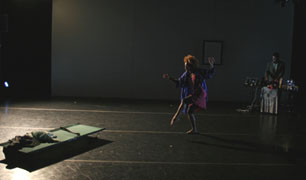
Jack Anderson
"La Voix"
 |
| Karine Plantadit in "La Voix" by John Selya. Photo by Burke Brown. |
Selya, Plantadit, and Cocteau
John Selya: "La Voix"
Joyce SoHo, 155 Mercer Street, SoHo
April 24-27, 2008 (closed)
Reviewed by Jack Anderson April 28, 2008
\A tour de force of acting became a tour de force of dancing in "La Voix," the dance-drama for Karine Plantadit that John Selya based on Jean Cocteau's "La Voix Humaine (The Human Voice)," a one-character play actresses have adored since the 1930's. Given its dramatic meatiness, it's easy to understand why, for it depicts a woman's frantic telephone conversation with the lover who is abandoning her and permits its interpreter to display many manifestations of longing, heartbreak, and despair.
The opportunity to show the body heightening, or sometimes contradicting, Cocteau's text obviously made his play attractive to Selya as choreographer. He and Christopher Freer, who codirected the production with him, offered a basically admirable adaptation, with Plantadit often speaking as she moved and at other times moving to taped words.
Plantadit was mesmerizing, nervously tossing on a bed or compulsively dashing to the phone hoping it would ring and she would hear her lover's voice. When she did hear him, although he was never heard by the audience, she tried to sound composed or even chipper, although her body was obviously tense. Thunderstruck by some emotion, she occasionally turned immobile, petrified by her own feelings.
There was an especially effective contrast between her words to her lover and her actions when she told him on the phone that she could not find a pair of his gloves, even as she was pressing them against her body. Here, the choreography permitted the woman to lie verbally about her feelings while her body was telling the audience the truth. So, too, there was an arresting moment when she froze in shock when she realized that her lover was not where he had given the impression of being, and the suspicion grew that he may have been at that moment with a new lover.
"La Voix" was set to a taped collage encompassing such miscellaneous musical sources as Billie Holiday, Steve Reich, Limp Bizkit, and Jacques Brel. Yet a commissioned score would have been more effective (although fine new scores are not easy to come by). A few other matters also made "La Voix" slightly bothersome. At the start, Ms. Plantadit was seen constructing her own bed, with no motivation provided for her manual labor. Conceivably, this may have been simply a way to begin the action and immediately focus the audience's attention on a stage without a curtain. Later, Mr. Selya briefly introduced a second dancer, Rika Okamoto, who seemed to symbolize some psychic force driving Ms. Plantadit. But this character soon departed and, in any case, looked unnecessary, dramatically mystifying and, finally, distracting. Cocteau, Selya, and Plantadit needed no one else.
"La Voix" shared the bill with "Tweaker," a brief compelling work for R.Colby Damon and Tucker Ty Davis in which exhilarating leaps gradually degenerated into convulsive jerks that traced the downward course of crystal meth addiction.
| museums | NYTW mail | recordings | coupons | publications | classified |
